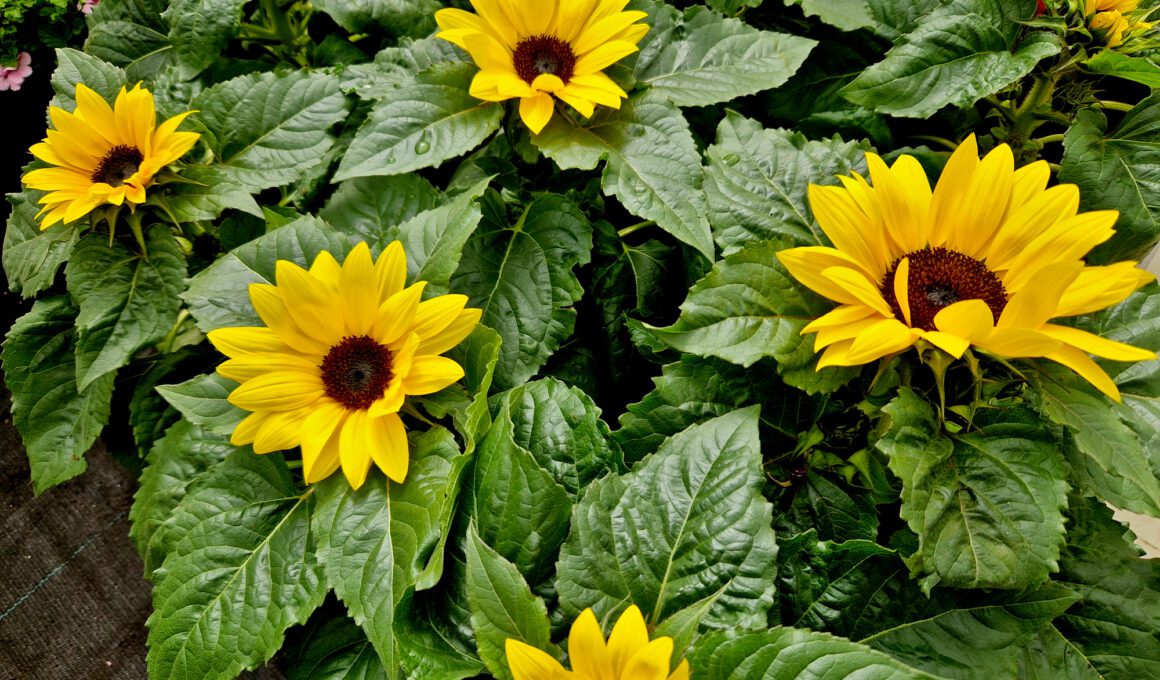Key Takeaways
- Choose safe and non-toxic mini sunflower varieties like ‘Pacino’ and ‘Teddy Bear’
- Find a spot in your yard with at least six hours of direct sunlight, avoiding areas with shadows
- Prepare soil with well-draining soil and enrich with compost or well-rotted manure
- Provide six to eight hours of sunlight daily and avoid overwatering
Choosing the Right Variety of Sunflowers
You’ll be amazed by the sheer variety of mini sunflowers you can choose from, each with its own unique charm and personality. When choosing the right variety of sunflowers, safety is a crucial factor to consider. Some mini sunflower varieties may have sharp edges or thorns that can cause minor injuries. Always opt for varieties that are known for their safety and non-toxicity. Varieties of dwarf sunflowers, like the ‘Pacino’ or ‘Teddy Bear’, are great options. They’re not just safe but also enchanting with their vibrant colors and compact size. The ‘Pacino’ variety offers a muted yellow hue and grows up to 2 feet tall, while the ‘Teddy Bear’ boasts fluffy, golden petals and reaches just about 1 foot in height. If you’re looking for a splash of color, the ‘Music Box’ variety showcases a mix of yellow and mahogany flowers. Among the many dwarf sunflower varieties, these mentioned ones will surely make your backyard a safe and delightful haven. Whichever variety you end up choosing, ensure it aligns with your safety needs and aesthetic preferences. This way, you’re not just growing mini sunflowers, you’re creating a sanctuary of beauty and safety right in your backyard.Identifying the Ideal Planting Location
Scouting out the perfect spot in the garden is crucial, as these little sun lovers need a minimum of six hours of direct sunlight each day. You can’t just plunk them down anywhere; sunflowers are very particular about where they grow. As you survey your backyard, keep these things in mind:- Look for garden beds that get plenty of full sun. This is absolutely necessary for mini sunflowers to thrive.
- Watch out for large trees or structures that might cast a shadow over your chosen spot as the day progresses.
- The area should have good drainage. Sunflowers don’t like to have wet feet.
- The site should be safe and secure, away from areas where kids play or pets roam, to avoid any accidental damage to your sunflowers.
Preparing the Soil for Planting
Before sowing any seeds, it’s crucial to prep the ground properly, ensuring it’s ready to nurture those tiny sprouts into vibrant, cheerful blooms. Preparing the soil for planting is a vital step in this process. Don’t think of it as just dirt; it’s the life-support system for your mini sunflowers. Start by choosing a well-draining soil. Sunflowers, like most plants, don’t appreciate having wet feet. Overly saturated soil can lead to root rot and other diseases. If your backyard soil doesn’t naturally drain well, consider amending it with coarse sand or organic matter to improve its drainage. After securing a well-draining soil, the next step is to enrich it with nutrients. Your mini sunflowers will be voracious eaters, requiring a rich diet to grow tall and produce those iconic yellow blooms. Add compost or well-rotted manure to the soil. These materials not only add essential nutrients to the soil but also help improve its structure and water-holding capacity. Don’t rush this process. Take your time to prepare the soil for planting. Remember, a healthy soil equals a healthy, blooming sunflower. Your backyard is about to become a sunflower haven, filled with joyful, yellow cheer.Understanding the Planting Process
Let’s dive right into the heart of the planting process, where a handful of seeds and a bit of patience can transform a simple patch of earth into a vibrant spectacle of color. To begin, you’ll need to select the right variety of mini sunflowers. I’d recommend a dwarf sunflower variety, as these are ideal for backyard planting. These smaller sunflowers still offer brilliant color but are more manageable in a home garden. Understanding the planting process is crucial to your success. Plant dwarf sunflowers about 6 inches apart, which provides them with plenty of room to grow. They need to be planted about 1 inch deep into the soil, ensuring their roots have a strong, safe anchor. Be sure to water them gently after planting. Remember, though dwarf sunflowers are low maintenance, they still require attention. Keep an eye on them and ensure they get six to eight hours of sunlight daily. Don’t overwater them, and protect them from harsh weather conditions or pests. With these precautions and care, your backyard will soon be a sunflower haven, bringing you joy every time you step outside.Caring for Your Seedlings
Nurturing those little seedlings can indeed be a delightful endeavor, as you’ll get to witness them gradually break through the soil and reach for the sky. The process of caring for your seedlings is one that requires attention, but it’s an utterly rewarding experience. Here are some safe and easy steps you can take to ensure your mini sunflower seeds become thriving plants.- Water gently: Make sure you’re not drowning your seedlings. They need a steady, but not overwhelming, supply of water. Overwatering can lead to root rot.
- Provide adequate sunlight: Sunflower seeds thrive in the sunlight. Position them in an area where they get at least six hours of direct sunlight per day.
- Protect from pests: Keep an eye out for any insects or animals that may be nibbling on your seedlings. Use safe, organic pest control methods if necessary.
- Support growth: As your seedlings grow, they may need some support. Use a small stick or a garden stake to help them stand tall.
Watering and Feeding Your Sunflowers
Now that you’ve successfully nurtured your seedlings, it’s time to delve into the particulars of watering and feeding those sun-kissed beauties for optimal health and vibrancy. Watering and feeding your sunflowers properly is vital to their growth and longevity. It’s crucial to provide your sunflowers with well-drained soil and keep the soil moist but not waterlogged. A sunflower’s roots need to breathe, and overwatering can lead to root rot. Here’s a basic guide to get you started:| Watering Frequency | Type of Fertilizer |
|---|---|
| Once a week | High-phosphorus |
| In hot and dry conditions, twice a week | Slow-release granular |
Dealing with Potential Pests
While you’ve been diligently caring for your sunflower plants, it’s crucial to stay vigilant for potential pests that could wreak havoc on these beautiful blooms. Pests are a common concern in any home garden, but don’t worry, you’re not alone in this. There are safe and effective ways to protect your dwarf sunflowers from these unwanted visitors. Firstly, keep an eye out for insects like aphids, beetles, and caterpillars, which are known to cause damage to sunflower plants. If you notice these critters, you can try safely removing them by hand or using a gentle stream of water to knock them off. For a more persistent problem, consider using an organic, non-toxic pesticide to maintain the safety of your garden and its ecosystem. Another potential pest you should be wary of is birds. Birds, particularly finches, love sunflower seeds and might make a meal of your mini sunflowers before you get the chance to enjoy them. Try using reflective tape or a scarecrow to deter them from feasting on your plants. Remember, dealing with pests is just part of the gardening journey. Stay patient and persistent, your beautiful, healthy dwarf sunflowers will thank you for it.Monitoring the Growth Process
It’s a sight to behold when those tiny seeds you’ve planted start to transform into robust, blooming dwarf sunflowers. This part of the process, monitoring the growth, is just as crucial as planting. Every stage matters when you’re trying to grow mini sunflowers successfully. To make it easier, here are some key steps to follow:- Keep an eye on the watering. Sunflowers in pots can dry out faster than those in the ground, so be attentive to their needs.
- Track the sunlight exposure. Mini sunflowers need about six hours of sunlight daily, so ensure they’re getting plenty.
- Be vigilant about pests. Even as the flowers grow, pests can still be an issue, so stay proactive.
- Watch out for signs of disease. Yellow leaves or spots can be a sign of trouble.
- Check on the growth rate. If your sunflowers aren’t growing as expected, it might be time to reassess your care routine.
Harvesting the Flowers
Once your vibrant blooms have reached their peak, you’ll be eager to harvest the flowers. This is a task that requires careful timing and technique. These dwarf sunflowers are an excellent addition to any backyard, not just for their beauty, but also for their ease of cultivation. Harvesting typically begins in late summer or early fall, but it’s crucial to wait until the flowers’ heads are completely open and their petals are starting to wilt. This ensures that the seeds are fully matured and ready for harvest. Get your gloves on and use a sharp pair of garden shears to cut the stem about one foot below the flower head. Be cautious not to pull or twist the stem, as this can damage the plant. It’s also important to note that mini sunflowers make excellent cut flowers, so feel free to adorn your home with your harvest! As you venture into the world of sunflower cultivation, always remember that patience and care are key components in harvesting. Keep these tips in mind and you’ll soon be reaping the rewards of your hard work, enjoying the beauty and charm these dwarf sunflowers bring to your backyard.Tips for Ongoing Maintenance and Care
Now that you’ve mastered the art of harvesting your mini sunflowers, it’s time to focus on their ongoing maintenance and care. This is just as crucial, if not more so, to ensure they remain healthy and vibrant. To help you out, here’s a handy table to guide you:| Task | Frequency | Importance |
|---|---|---|
| Deadhead spent flowers | Weekly | Prevents energy waste and promotes new growth |
| Water thoroughly | 2-3 times per week | Keeps roots hydrated without causing root rot |
| Check for pests | Daily | Early detection leads to effective pest control |
| Rotate the pot | Every 2-3 days | Ensures even sunlight exposure |
| Fertilize | Monthly | Supplies essential nutrients |
Some Quick FAQs To Get You Growing Dwarf Sunflowers
How do I grow mini sunflowers in my backyard?
To grow mini sunflowers in your backyard, you will need to follow these steps:What are dwarf sunflowers?
Dwarf sunflowers, also known as miniature sunflowers, are sunflower varieties that grow to be smaller in size compared to traditional sunflowers.Can I grow mini sunflowers in pots?
Yes, you can grow mini sunflowers in pots. This is a great option if you have limited space or if you want to have portable sunflowers that can be moved around to receive optimal sunlight.How do I grow dwarf sunflowers from seeds?
To grow dwarf sunflowers from seeds, you will need to sow the seeds directly into the soil in early spring when the danger of frost has passed.How tall do miniature sunflowers grow?
AMiniature sunflowers typically grow to be around 18 inches tall.When do mini sunflowers bloom?
Mini sunflowers usually bloom in late spring or early summer, depending on the specific variety and growing conditions.How often should I water my mini sunflowers?
Mini sunflowers require regular watering, especially during the hot summer months. Aim to keep the soil slightly moist, but be careful not to overwater as this can lead to root rot.Can I Use the Same Techniques to Grow White Marigolds as I Would for Mini Sunflowers?
When it comes to growing white marigolds, the techniques required may not be the same as those used for mini sunflowers. These delicate flowers necessitate unique care and attention. Make sure to provide them with well-draining soil, sufficient sunlight, and regular watering. Consider researching specific techniques to ensure successful cultivation of your beautiful white marigolds.









